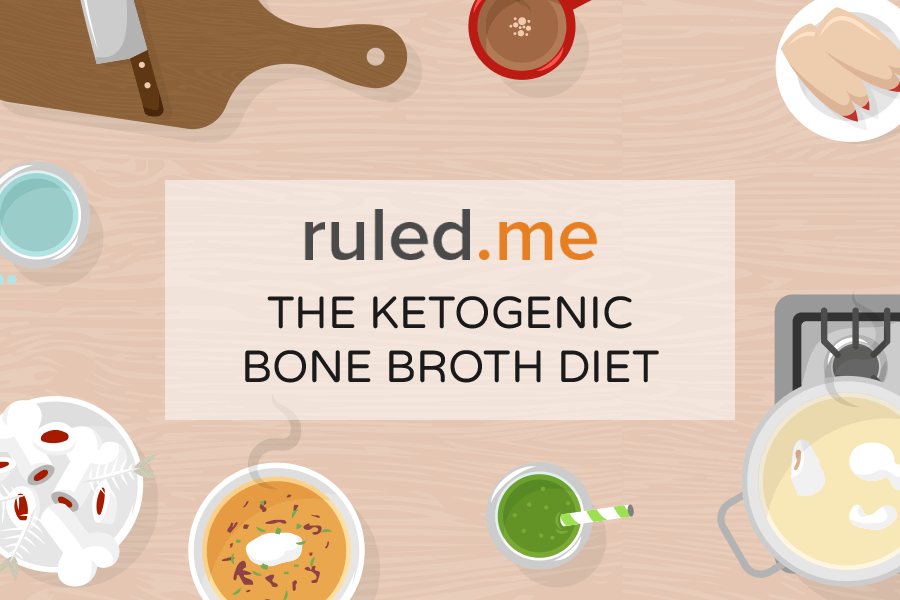Keto bone broth has hit the health scene as the next healing elixir. Many health gurus and naturopaths tout bone broth as being good for weight loss, detoxification, and joint health, but is there any truth to this?
On the surface, it sounds like another health fad.
The Truth About The Bone Broth Diet and Bone Broth
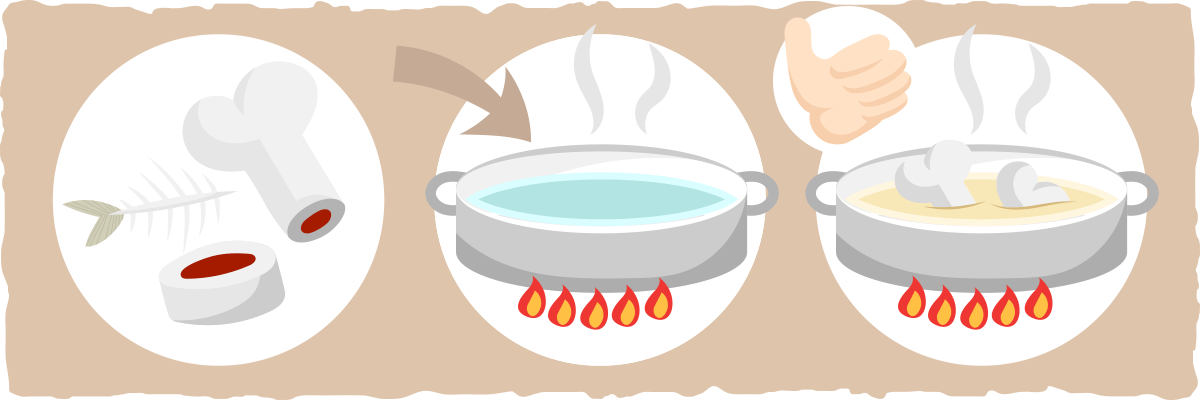
Bone broth has been gaining popularity lately due to the recent release of the book titled “Dr. Kellyann’s Bone Broth Diet” and the plethora of bone broth protein products on supplement store shelves. Even people who are not health-conscious have been getting doses of bone broth on NPR, Time Magazine, Today, ABC News, and New York Times.
The concept is simple enough. Put bones in water, simmer them for hours to days, and you get a bone broth with nutrients that many of us don’t get in our diets.
But before you get caught up in the whirlwind of another health fad, it is important to understand if bone broth is as beneficial as many gurus, practitioners, and publications claim.
Let’s start with the bone broth diet. The results that people get after just 21 days on this diet are quite remarkable, but what does bone broth have to do with it?
The 21-Day Paleo Fasting Plan (Bone Broth Optional)
When we look closer at the Bone Broth Diet, it is easy to see where the results are really coming from. The first 21 days of the diet consist of a 5-day modified Paleo diet with a 2-day bone broth fast.
Almost everyone who switches from a western type diet to a Paleo diet will experience health improvements and weight loss. This is mainly because the Paleo diet removes processed foods from your diet and replaces them with high fiber and high-protein foods that are much more satiating. The consumption of these types of foods (i.e., vegetables and high-quality meats) cause you to eat more vitamins, minerals, and antioxidants and fewer calories than before. The result is fat loss and better health.
When you add a weekly 2-day fast to this paleo diet then you will increase the weight loss and health improvements even further. The 2-day fast will stimulate weight loss and health improvement due to the combination of a lack of calories, autophagy, and ketosis. If you’re interested in learning more about fasting, feel free to read our article on Intermittent Fasting on a Ketogenic Diet >
(For clarification on the science terms: autophagy is the process of cellular clean-up that helps your cells function more efficiently and removes damaged, cancerous cells. Ketosis is when your body burns fat and ketones for fuel. These two processes are what make fasting a valuable adjunct to treatments for cancer, infection, and obesity.)
If someone simply fasted for 2 days every week without any other dietary or lifestyle changes, it would lead to rapid weight loss (up to four pounds of water weight in the first week). Over the course of 21 days, the person would lose fat and have better health parameters (as long as they don’t overeat on non-fasting days).
What happens when the 2-days of fasting is followed by the Paleo diet? An incredible health improvement plan that will help you lose weight and inches. This will happen regardless if you include bone broth in the diet or not.
This means that bone broth is not the reason why people lose so much weight and feel better on the Bone Broth Diet. (But, it may be the reason why people lose wrinkles — more on that later.) A better name for this diet would be the “21-Day Paleo Fasting Plan (Bone Broth Optional)”.
However, this does not mean that bone broth is useless. There is some merit behind the health claims about the miraculous effects of bone broth. In fact, it can provide each diet (especially the ketogenic diet) with health-promoting nutrients that it is missing.
A Life Without Bone Broth
Let’s look at the ketogenic diet, for example. Meat is the main source of protein for ketogenic dieters.
This is wonderful for building and maintaining muscles, connective tissue, and other cells, but it can also trigger mechanisms that promote cancer growth and heart disease. This is due to specific amino acids that are found in high levels in meat protein.
A Potential Problem with Too Much Meat? IGF-1, mTOR, and Cancer
When we consume protein from meat, the body responds by releasing a hormone called insulin and activating two pathways called IGF-1 and mTOR so that you can utilize the protein to promote the growth of your cells.
In other words, insulin, IGF-1, and mTOR cater a party for your cells to celebrate the abundance. As we age, however, cancerous cells start to crash the party.
When we are children (and after we finish an intense workout), the amino acids from the meat protein we consume tend to aid the growth of cells necessary for our health (e.g., the cells in our bones, muscles, blood, and organs).

However, when we are fully grown, rarely work out, and overconsume meat each day, cancer cells are more likely to feed and thrive off of the catering that IGF-1, mTOR, and insulin provide.
An Overabundance of Leucine and Methionine: The Real Culprit & Its Simple Solution
One particular amino acid called leucine is a potent stimulator of the secretion of insulin and the activation of the IGF-1 and mTOR pathways. Meat and dairy proteins tend to be highest in leucine, which is why products like whey protein and chocolate milk are heavily marketed as “muscle builders.” In the context of an unhealthy diet and lifestyle, however, they may stimulate the growth and proliferation of cancer cells and disease as well.
Another amino acid that can cause problems when consumed in high amounts is methionine. This amino acid is abundant in dairy and meat proteins, and it leads to an increase in homocysteine levels in the blood. Homocysteine is a significant risk factor for serious diseases like heart disease, stroke, and mental illness.
The effects that consuming too much leucine and methionine have on an inactive body may explain why red meat consumption has been found to be associated with cancer and heart disease in some studies. However, this doesn’t mean that you should switch to a vegan ketogenic diet.
In fact, by eating more than just the muscle meat from the animal, we can mitigate the potential adverse effects of consuming too much leucine and methionine. This is because animal skin and connective tissue contain high amounts of several other amino acids that can help prevent disease, cancer growth, and intestinal issues.
What does this have to do with the Bone Broth Diet? One of the best sources of these amino acids is bone broth.
The Brilliant Benefits of Bone Broth
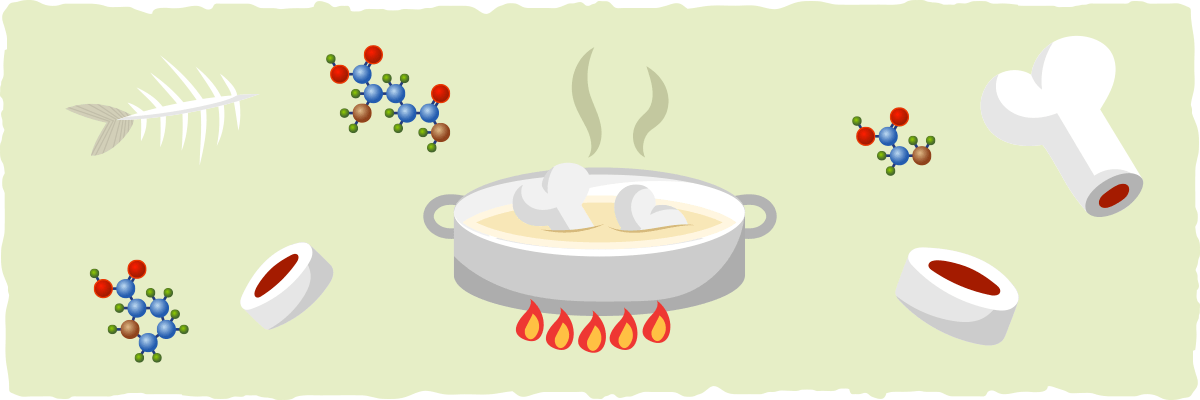
Bone broth is a savory liquid consisting of the water in which the bones and cartilage of meat or fish have been simmered. The nutritional content of each bone broth varies based on the bones used, cooking time, and cooking method, but you can almost guarantee that you will find these nutrients to some degree in every bone broth (and experience their health benefits).
Collagen and Gelatin
Collagen makes up about 30 percent of the protein in your body and is the main component of connective tissues like cartilage, ligaments, tendons, bone, and skin. Gelatin forms when the collagen is simmered during the process of making bone broth, which gives the broth a Jell-O like consistency when it is cooled.
Although this technically is an animal protein, it has much less leucine than the protein found in meat and dairy. It also has less leucine than common vegan sources of protein like soy.
But don’t let the lack of leucine fool you. Collagen still supports the growth of muscle tissue. (You may not need whey protein after all.)
Consuming collagen helps us build healthy skin as well. One double-blind, placebo-controlled clinical study from 2015 found that supplementing with only 2.5 grams of collagen peptides lead to a clear improvement in cellulite and improved skin health over a period of 6 months.
Another study found that supplementing with collagen protein improved skin health after only 4 weeks in elderly women. These results are amazing for such a small amount of a protein that we rarely pay attention to.
What is to blame for these outstanding results? The unique combination of amino acids that are found in bone broth.
Glycine
Collagen contains an abundance of the amino acid glycine (in higher amounts than any other food). Glycine helps control blood sugar levels and prevents the negative effects caused by having too much methionine.
Glycine is also important for the production of myoglobin and hemoglobin for oxygen transport in the muscle and blood respectively. This means that it improves your exercise performance and your ability to recover from those exercises.
The digestive system is aided by glycine as well. It protects us from gastric ulcers, stimulates stomach acid production, and helps us digest fats. The effects of glycine are also felt in almost every other cell in the body because it restores the body’s master antioxidant, glutathione.
Proline
About seventeen percent of collagen is made up of an amino acid called proline. Proline helps regulate mTOR — aiding in cell growth and proliferation, while it clears up waste products and free radicals from cells. The effects of proline make it less likely that the activation of the mTOR pathway will lead to cancer growth.
Glutamine
Glutamine is abundant in the blood and is one of the few amino acids that can cross the blood-brain barrier. It is essential for the health of the intestinal barrier of our gut and the function of our immune cells because these cells prefer to consume glutamine for energy.
Glycosaminoglycans
When you make bone broth using bones with the tendons, ligaments, and cartilage still attached, you will find natural sources glycosaminoglycans in it.
Not familiar with the term?
How about the popular joint support supplement called chondroitin sulfate? This is a glycosaminoglycan that is found in the cartilage, and it protects our joints from wear and tear.
Glycosaminoglycans are complex carbohydrates that attach to proteins to form parts of your connective tissue and synovial fluid (the lubricant that surrounds some of your joints). They also play an important role in skin health by promoting skin hydration and wound repair. Combine this with the beneficial effects that collagen has on reducing cellulite and improving skin health, and you have a skin health supplement in your bone broth that actually works.
Specific glycosaminoglycans serve other important roles in the body as well. The glycosaminoglycan called heparin sulfate has been shown to help regulate immune system function, and the most well-known glycosaminoglycan, chondroitin sulfate, plays an important role in boosting our cognitive function.
What About Minerals? The Big Bone Broth Blunder
Many popular bloggers, diet gurus, and even some doctors tout bone broth as being packed with minerals, but is there any evidence to back up this claim?
The short answer is “no”.
The research on bone broth is scarce. Most of the conclusions about its mineral content are based on the assumption that bone broth must contain a lot of minerals because bones have a lot of minerals.
This is a reasonable assumption, but when it was put to the test twice, it failed. The first scientific study that I could find on bone broth was published back in 1934. It found that chicken bone broth contained only a trace amount of minerals, but this was over 80 years ago. We need something more recent to confirm these findings.
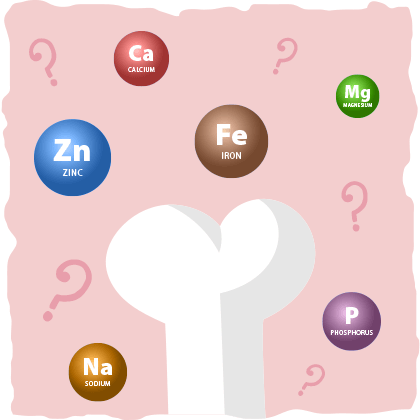
In 2014, one of the readers of Alive.com sent multiple batches of bone broth and vegetable broth to the lab for mineral analysis. What were the results?
After 3 large bison bones were pressure cooked for 24 hours, the only significant change was in sodium and potassium content. Sodium increased by about a gram per liter of broth and potassium by a little over half a gram per liter.
Compare that to the vegetable broth that was made from nettles and dandelion leaf and pressured cooked for only 3 hours then left to steep overnight. In this broth, potassium was 3x higher and magnesium was 5x higher than the bone broth. So, should you use nettle and dandelion broth instead?
My suggestion is to stick with collagen and glycosaminoglycan rich bone broth for all of the benefits we went over earlier. If you are looking to supplement with minerals then you can make a low-carbohydrate vegetable soup using your bone broth as the broth. Add in some vegetables like spinach, swiss chard, kale, and asparagus because they are packed with potassium and magnesium.
You can also try one of our soup recipes (like the BBQ Chicken Soup or the Roasted Red Bell Pepper and Cauliflower Soup), and have it with a Red Pepper Spinach Salad. Put some avocado on the salad and use bone broth as the base for your soup, and you’ll have a delicious, nutrient-packed, and keto-friendly meal.
The Takeaway — The Ketogenic Diet is Better With Bone Broth
By adding bone broth to your keto lifestyle (along with other health-promoting foods and resistance training), you can maximize the benefits of keto while minimizing the potential downsides of too much leucine and methionine.
Bone broth is packed with the highest amount of glycine compared to any other food. This amino acid, as well as the other amino acids found in bone broth, can help improve many aspects of health.
For quick and easy reference, here are the tried and true benefits of bone broth:
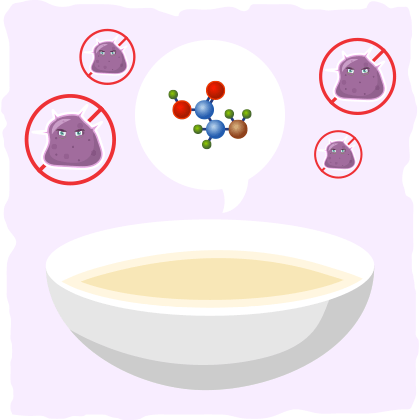
- Bone broth is satiating. Bone broth and bone broth soups are rich, nourishing, and satisfying. It has virtually zero carbs and few calories, so you can indulge in bone broth even while you are on the ketogenic diet or fasting.
- Bone broth is packed with collagen. Collagen helps reduce cellulite, improve skin health, and increase lean muscle mass.
- Bone broth helps detoxify your body. It contains the amino acids glycine and proline, which aid your liver in removing toxins from your body.
- Bone broth heals your gut. It helps your digestive system by healing the gut and curing digestive problems.
- Bone broth heals your joints. Bone broth gives you a generous supply of heparin sulfate, chondroitin sulfate, and other glycosaminoglycans that help heal your joints and skin.
- Bone broth is anti-inflammatory. The gut healing and detoxifying properties of bone broth and its amino acids help reduce inflammation.
And guess what? You can have bone broth at any time you want. All you have to do is make it at home, find it at a health food store, or order it straight to your door.
The Best Sources of Bone Broth
Now you know that bone broth contains nutrients essential for the health of every cell in the body, and it can be a valuable addition to every diet (especially the ketogenic diet), but where do you get it?
It is best to get your bone broth from people that source their bones from healthy animals. Here are some high-quality bone broth sources that will ship to directly to your place:
But if you’re feeling ambitious and want to guarantee that you will get all of the benefits from the bone, tendon, cartilage, and ligaments, I suggest making your own bone broth.
The Simplest Bone Broth Recipe
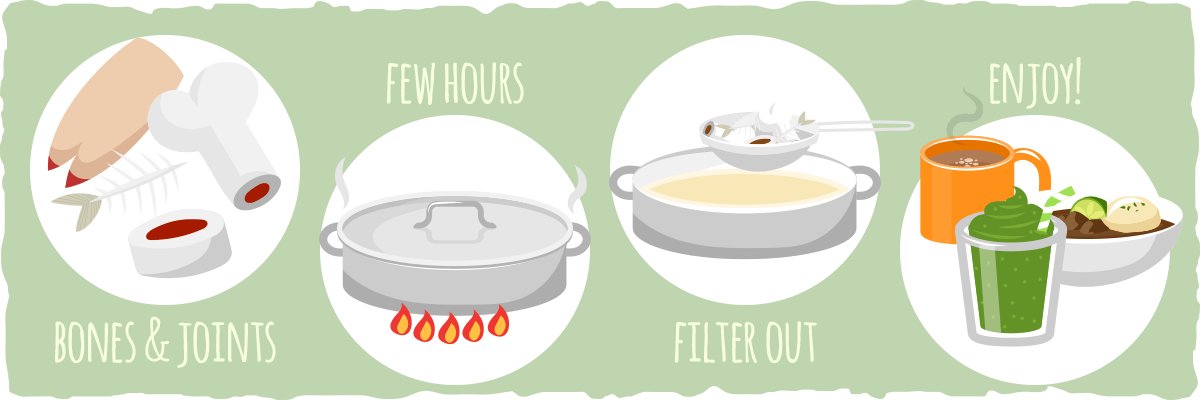
Making bone broth is easier than you think. All it takes is high-quality bones, water, heat, and patience.
Step 1
Save the bones and cartilage from something you already ate, or purchase bones from a quality source like U.S Wellness Meats or White Oak Pastures.
For example, you can use the bones from a chicken, duck, or lamb leg that you just ate.
Bonus Tip: Some of the best broth that I’ve ever made was from two pig feet. It was filled with so much gelatin and glycosaminoglycans that it was like Jell-O at room temperature. Using parts of the animal that has very little meat, but a lot of cartilage, ligaments, tendons, and skin is the best way to make a bone broth that is filled with collagen, gelatin, and glycosaminoglycans. Fish heads, chicken feet, oxtail, and pig feet are all perfect examples of this, and they all make the healthiest broths.
Step 2
Put the bones in a pot, a slow cooker, or a pressure cooker and cover them with water.
- If you’re using a pot, bring the water to a simmer and cook the bones for 8-24 hours.
- If you’re using a slow cooker, cook the bones on the low setting for 8-24 hours.
- If you’re using a pressure cooker, you only need to cook the bones for 2-3 hours.
Bonus Tip: Add 1-2 tablespoons of apple cider vinegar to the water and let the bones soak for 30 minutes to modestly increase the mineral content of your bone broth.
Flavor Tip: Add half a small onion, a chopped carrot, a stalk of celery, and a pinch of sea salt to improve the flavor of your broth.
Step 3
Sift out all solid particles by using a mesh strainer, so that you have a liquid broth with no solid particles floating in it.
Step 4
Use the broth as a base for soups, add the broth to smoothies, drink it as a hot beverage, store it in the fridge for up to 5 days or freeze it.
How To Add Bone Broth To The Ketogenic Diet
Bone broth is the perfect addition to the ketogenic diet, and the best part is that you can consume it in many different ways. Here are four ways you can get bone broth’s health benefits into your diet:
1. Use your favorite bone broth as the broth for every soup that you make.
2. Drink the bone broth as a hot, comforting beverage.
3. Supplement your diet with bone broth protein or a collagen supplement.
4. Make gelatinous keto-friendly snacks like sugar-free gummy candy or start a party with Keto Gelatin Rum Shots using appropriately flavored broth.
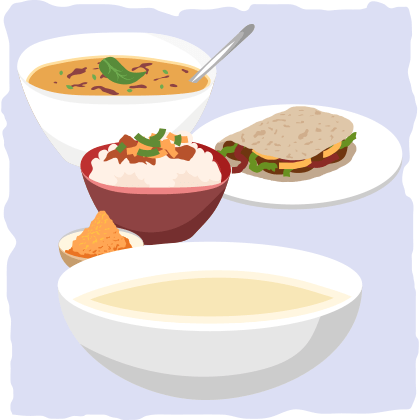
If you are looking for a reliable collagen or gelatin supplement, I highly recommend Great Lakes Gelatin Collagen Hydrolysate (good for smoothies and protein shakes) and Great Lakes Beef Gelatin (good for making things thicker and more gelatinous). These protein supplements are sourced from pasture-raised cows, making it better for you and for the environment.
On the other hand, if you are aiming to make the most nutrient-dense broth possible, then you should use the most tendinous and gelatinous parts of the animal. Earlier, I mentioned how I made a great broth from pig’s feet, but oxtail is even better because you can make dinner out of it as well.
You can start your bone broth journey by making Keto Slow Cooker Keto Oxtails. While you chow down on this delicious dish, continue slow cooking the parts that you can’t eat into a nutrient-dense bone broth for future use.
Or — if you are looking to get into ketosis quickly — you can combine bone broth with fasting.
The Bone Broth Fast — A Ketosis Kickstart for The Ketogenic Diet
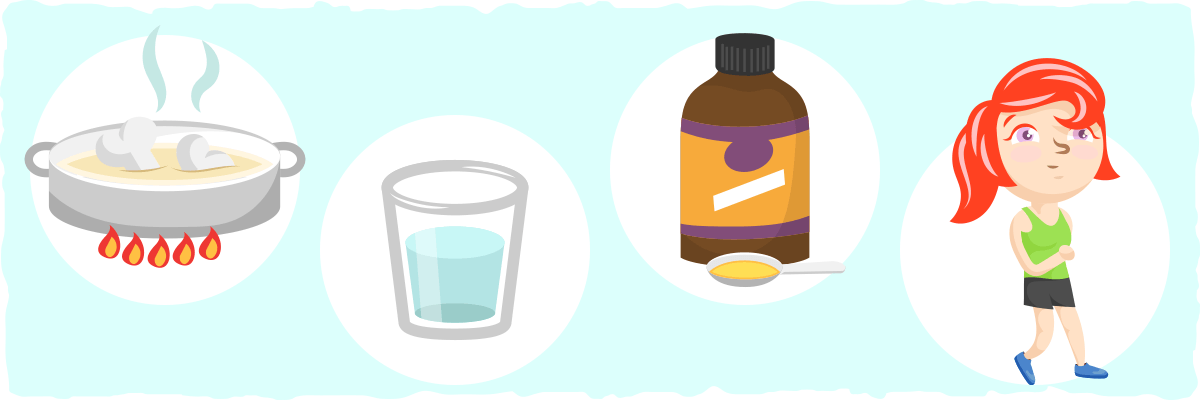
The Bone Broth Diet suggests fasting from everything but bone broth and water for 2 days a week. This can provide helpful health and weight loss boost, but the benefits don’t stop there for ketogenic dieters.
Bone broth has little to no carbs and provides you with a feeling of nourishment as you fast. It also helps you replenish the fluids that you will lose during fasting (because fasting reduces insulin and glycogen levels). This makes it much easier to handle fasting, while it triggers fat and ketone burning much more quickly than the ketogenic diet can. Basically, this means that a 2-day bone broth fast is the perfect ketosis kickstarter.
During the two-day bone broth fast, you can consume MCT oil and go for an hour-long walk to speed up your transition into ketosis. After the two-day fast, follow the rules of our ketogenic diet guide to reap the benefits of ketosis without having to fast anymore.
Putting It All Together
Although the upsides of bone broth are blown out of proportion by many popular health gurus, it is still the perfect addition to every diet — especially the ketogenic diet.
The amino acids in bone broth help almost every cell detoxify and heal, while the glycosaminoglycans in the bone broth improve the health of the joints, skin, immune system, and brain.
To reap the benefits of bone broth, you can buy it online or in stores. However, these broths aren’t as healthy as the bone broth that you can make at home. Simply by slow cooking the most collagenous and cartilaginous animal parts (e.g., oxtail, fish head, chicken feet, pigs feet), you can make the healthiest bone broth.
Not a fan of all the cooking involved with bone broth? You can supplement with bone broth protein or collagen powder by putting it in a smoothie or protein shake to get most of the benefits of bone broth.
Either way, it doesn’t matter how you decide to consume it. Whether drink it, cook with it, or supplement with it, bone broth is a healthy addition to every diet.
Sources:
- The Bountiful Benefits of Bone Broth: a Comprehensive Guide — Chris Kresser
- The mTOR Signalling Pathway in Human Cancer — NCBI
- Nutrition, insulin, IGF-1 metabolism and cancer risk: a summary of epidemiological evidence. — NCBI
- Leucine supplementation improves acquired growth hormone resistance in rats with protein-energy malnutrition. — NCBI
- Low protein intake is associated with a major reduction in IGF-1, cancer, and overall mortality in the 65 and younger but not older population. — NCBI
- Collagen peptide supplementation in combination with resistance training improves body composition and increases muscle strength in elderly sarcopenic men: a randomised controlled trial — NCBI
- Dietary Supplementation with Specific Collagen Peptides Has a Body Mass Index-Dependent Beneficial Effect on Cellulite Morphology — NCBI
- Over-stimulation of insulin/IGF-1 signaling by western diet may promote diseases of civilization: lessons learnt from laron syndrome — NCBI
- The Amino Acid Composition of Mammalian Collagen and Gelatin — NCBI
- The Associations of Diet with Serum Insulin-like Growth Factor I and Its Main Binding Proteins in 292 Women Meat-Eaters, Vegetarians, and Vegans — Cancer Epidemiology, Biomarkers & Prevention
- PROTEIN DEBATE: Which Protein Is Best? — Hammer Nutrition
- Glycine restores glutathione and protects against oxidative stress in vascular tissue from sucrose-fed rats. — NCBI
- Bone Broth Analysis: Reader Research — Alive
- Bone and vegetable broth — NCBI
- Bone Broth — Dr. Kellyann
- The Bone Broth Diet — Kettle and Fire
- Bone Broth Diet: Brilliant or Bust? — The Healthy Home Economist
- Dietary Supplementation with Specific Collagen Peptides Has a Body Mass Index-Dependent Beneficial Effect on Cellulite Morphology — Journal of Medicinal Food
- Discoveries of Mechanisms for Autophagy — Nobel Prize
- Tim Ferriss – 3 Day Fast Protocol Details – Get into Ketosis Quicker and Easier — Eat. Move. Hack.
- Autophagy Is Required to Maintain Muscle Mass — Cell
- Fasting Cycles Retard Growth of Tumors and Sensitize a Range of Cancer Cell Types to Chemotherapy — NCBI
- Fasting and cancer treatment in humans: A case series report — NCBI
- Physical exercise increases autophagic signaling through ULK1 in human skeletal muscle — American Physiological Society
- Acute nutritional ketosis: implications for exercise performance and metabolism — BioMed Central
- Oral supplementation of specific collagen peptides has beneficial effects on human skin physiology: a double-blind, placebo-controlled study. — NCBI
